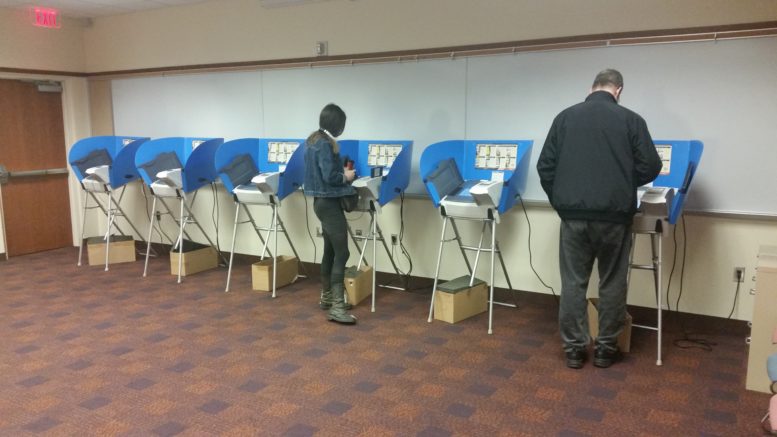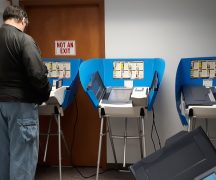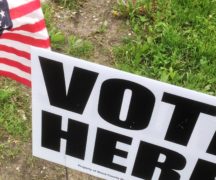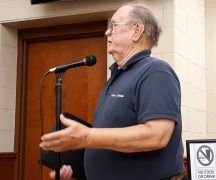By JAN LARSON McLAUGHLIN
BG Independent News
The strict voter purging process used in Ohio was given the stamp of approval by the U.S. Supreme Court earlier this week.
The Wood County Board of Elections – like the rest of the state – has been on hold since the legitimacy of the voter purging has been debated in the courts. But soon, people will again be dropped from the voter rolls if they don’t meet state requirements.
The local board of elections will be charged with making the cuts. Carol DeJong, one of the directors at the Wood County Board of Elections, said her opinion on the court ruling was irrelevant.
“We are Switzerland here at the board of elections,” she said on Wednesday.
“We will of course have to wait till we get instructions from the state,” DeJong said. But since the process of reviewing voting rolls is customary in January and February, she didn’t expect any voters would be purged prior to the general election this fall. The National Voter Registration Act prohibits dropping voters too close to an election, she said.
“I don’t expect that we will hear anything new until the beginning of 2019,” she said.
The last time Wood County did any purging of voter names was in 2015.
That year more than 3,400 registered voters in Wood County were purged from the voting rolls following a directive from the Ohio Secretary of State Jon Husted.
However, in 2016 a federal appeals court found that Ohio’s process for maintaining its voter rolls violated federal law. A judge ruled that Ohio voters who were improperly removed from registration lists could cast ballots in the 2016 presidential election.
But since those names had already been purged, the ruling meant if a person showed up at the polls and was not on the official list, they would be allowed to vote by a provisional ballot. A provisional ballot is a paper ballot that is held in a sealed envelope with the voter’s identification. If the identification information was verified by the elections board staff, the provisional ballot was counted.
Wood County Board of Elections did not encounter any citizens purged from the list, who wished to vote, Director Terry Burton said.
“Those people had been through an eight-year process,” of not voting and not responding to notices, he said.
But those who send back the stamped envelope will keep their place on the voter rolls.
“Those people we hear from, their status is active,” DeJong said.
Bowling Green sees a lot of inactive voters due to its university population, she said.
“Kids are here for a while, they get registered here for a while, then they more,” DeJong said. And for those who move out of state, there is no system in place to know if they have registered elsewhere.
The case that put the spotlight on the voter purging was brought by Larry Harmon, a software engineer and Navy veteran who lives near Akron. He voted in the 2004 and 2008 presidential elections but not in 2012. He also sat out the midterm elections in 2010 and 2014.
But in 2015, Harmon did want to vote against a ballot initiative to legalize marijuana and found that his name had been cut from the voting rolls. State officials said that they had done so after sending Harmon a notice in 2011 asking him to confirm his eligibility to vote and that he did not respond. Harmon said he did not remember getting a notice, but he was dropped from the voter rolls.
Since then, the voter purging has been debated in the courts. A lower court ruling found the state policy violated a federal law aimed to make it easier for U.S. citizens to register to vote. The 1993 National Voter Registration Act bars states from striking registered voters “by reason of the person’s failure to vote.”
Ohio is one of seven states, along with Georgia, Montana, Oklahoma, Oregon, Pennsylvania and West Virginia, that erase infrequent voters from registration lists. Ohio’s policy is the most aggressive.
Registered voters in Ohio who do not vote for four years are sent registration confirmation notices. If they do not respond and do not vote over the subsequent four years, their names are purged from the voting rolls.
Husted has maintained that the purging is legal and that over five years his office has removed 465,000 deceased voters and 1.3 million duplicate registrations.
By a 5-4 vote that split the conservative and liberal justices, the Supreme Court rejected arguments in a case from Ohio that the practice violates a federal law intended to increase the ranks of registered voters.
Voter access to polls is being debated around the nation. Democrats have accused Republicans of trying to suppress votes from minorities and poorer people who tend to vote for Democrats. Republicans have argued that they are trying to promote ballot integrity and prevent voter fraud.
Civil rights groups said the court should be focused on making it easier for people to vote, not allowing states to put up roadblocks to casting ballots.
DeJong said boards of elections will be waiting till next year to do any purging – especially since a new secretary of state will be elected this fall.
“We will get a full set of instructions from the secretary of state,” she said.




